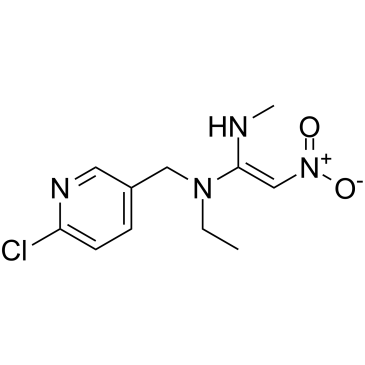Nitenpyram

Nitenpyram structure
|
Common Name | Nitenpyram | ||
|---|---|---|---|---|
| CAS Number | 150824-47-8 | Molecular Weight | 270.715 | |
| Density | 1.3±0.1 g/cm3 | Boiling Point | 417.2±45.0 °C at 760 mmHg | |
| Molecular Formula | C11H15ClN4O2 | Melting Point | 72ºC | |
| MSDS | Chinese USA | Flash Point | 206.1±28.7 °C | |
| Symbol |

GHS07 |
Signal Word | Warning | |
|
Capillary electrophoresis-mass spectrometry as a new approach to analyze neonicotinoid insecticides.
J. Chromatogr. A. 1359 , 317-24, (2014) This paper represents the first report of a capillary electrophoresis (CE) method compatible with mass spectrometry (MS) detection for simultaneously analyzing seven neonicotinoid insecticides (acetamiprid, clothianidin, dinotefuran, imidacloprid, nitenpyram,... |
|
|
Simultaneous determination of neonicotinoid insecticides in human serum and urine using diatomaceous earth-assisted extraction and liquid chromatography-tandem mass spectrometry.
J. Chromatogr. B. Analyt. Technol. Biomed. Life Sci. 969 , 85-94, (2014) A rapid and sensitive analytical method was developed for simultaneous determination of eight neonicotinoid insecticides (acetamiprid, clothianidin, dinotefuran, flonicamid, imidacloprid, nitenpyram, thiacloprid and thiamethoxam) and three specific metabolite... |
|
|
Simultaneous determination of neonicotinoid insecticides in sunflower-treated seeds (hull and kernel) by LC-MS/MS.
Food Addit. Contam. Part A. Chem. Anal. Control. Expo. Risk Assess. 33 , 442-51, (2016) A validated analytical method to determine seven neonicotinoids (dinotefuran, nitenpyram, thiamethoxam, clothianidin, imidacloprid, acetamiprid and thiacloprid) in sunflower seeds (hull and kernel) using HPLC coupled to electrospray ionisation mass spectromet... |
|
|
Biological Monitoring of Human Exposure to Neonicotinoids Using Urine Samples, and Neonicotinoid Excretion Kinetics.
PLoS ONE 11 , e0146335, (2016) Neonicotinoids, which are novel pesticides, have entered into usage around the world because they are selectively toxic to arthropods and relatively non-toxic to vertebrates. It has been suggested that several neonicotinoids cause neurodevelopmental toxicity ... |